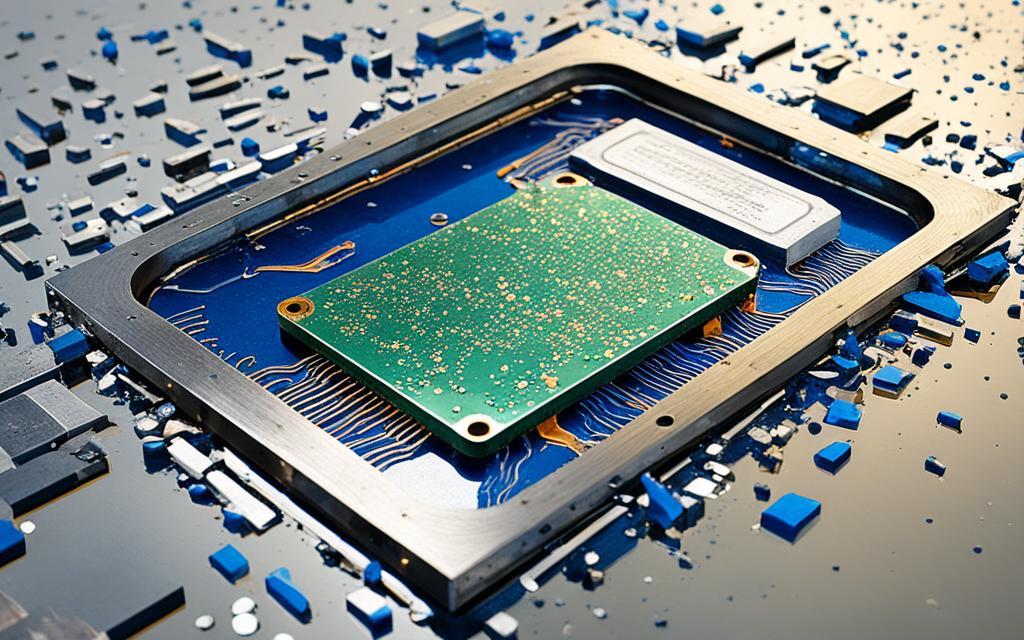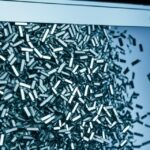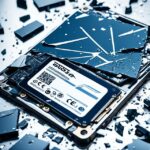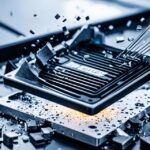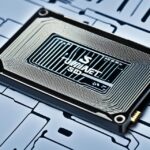Table of Contents
In today’s world, keeping sensitive information safe is more important than ever. SSDs are becoming more popular because they are fast, last a long time, and use less power than old-style hard drives. However, simply deleting files from an SSD isn’t enough. This is because of the way SSDs are made, which can let parts of deleted files be recovered1. So, it’s really important to know how to completely destroy an SSD. Doing this helps keep your own and your organisation’s data safe.
We’re going to look at different ways to make sure data on an SSD is gone for good. We will talk about both software methods and ways to physically damage the drive so no data can be got back from it. Since physically breaking an SSD makes it very hard for anyone to access or recover data, we will see why and when you might want to do just that1.
Key Takeaways
- SSDs require specialised techniques for effective data eradication.
- Simply deleting files does not guarantee complete data removal on SSDs.
- Physical destruction methods like shredding are highly effective.
- Extreme temperatures may damage SSDs but don’t ensure total data destruction.
- Specialised tools like the Crunch 250 Hard Drive Destroyer are crucial for compliance with data regulations.
- Professional equipment and trained personnel are essential for safe and effective destruction.
Understanding SSDs: How They Work and Importance of Data Destruction
Understanding SSDs is key as the digital world grows. Solid State Drives, or SSDs, use NAND flash memory for quick data access. This eliminates mechanical parts found in HDDs, increasing efficiency.
The Mechanism of NAND-Based Flash Memory
The way NAND flash memory works is vital for SSDs. Data in SSDs gets written and read swiftly thanks to memory cells. But, SSDs can only be written to a limited number of times.
This affects their lifespan. Wear-leveling helps by spreading out the data, extending the drive’s life. Yet, erasing data from SSDs can be tricky, risking the drive’s health because of how data spreads across it2.
Why SSDs Store Data Differently Than HDDs
SSDs and HDDs store data very differently, which affects security. SSDs use flash memory, needing unique data erasure methods. When getting rid of an SSD, special steps ensure data is gone for good. This often includes destroying them physically, due to integrated circuits3.
Proper disposal is a must, more so for sensitive data on SSDs4. Companies must follow strict rules to protect data privacy and avoid legal problems.
Why Simply Deleting Files Is Not Enough
Organisations often think that deleting files from their SSDs gets rid of sensitive info for good. But the truth is, SSD data recovery risks are still high after deleting files because of the way these drives work. When you delete a file, the operating system just marks its space as empty, without actually removing the data5. This means pieces of deleted files can still be found by those who know how to look, making it clear that just deleting files does not fully protect your data.
The Risks of Data Recovery from SSDs
Even when data on SSDs seems gone, it can often still be brought back, showing the need for strong security. About 70% of people wrongly think wiping SSDs clean protects their data6. This mistake can make them too confident and put their information at risk. The issue is really serious for sectors that have strict rules for keeping data safe, and it proves secure erasing practices are a must.
Reflections on File Deletion Technologies
Normal ways of deleting files don’t work well on SSDs because of how these drives are made. While old methods are okay for HDDs, SSDs need a different approach that erases data without harming the storage cells6. This is why we need better ways to get rid of data, especially when the law says we must completely destroy drives to ensure the data can’t be accessed7. It’s crucial to take steps to wipe data properly, not just for the law, but to keep important information safe.
| Method | Effectiveness | Appropriate For |
|---|---|---|
| Standard Deletion | Inadequate | General Use |
| Software Wipes | Moderate | Non-Critical Data |
| Physical Destruction | 100% secure | Sensitive Information |
How to Destroy a SSD: The Ideal Methods
It’s vital to destroy an SSD to protect sensitive info. Knowing how to correctly destroy an SSD ensures that private data doesn’t get exposed. You can either physically destroy the SSD or use data erasure software.
Overview of Physical Destruction Techniques
Physical methods are the best for permanently deleting data from SSDs. Shredding SSDs into tiny bits is very effective. This makes recovering any data impossible. Many SSD makers support these methods and offer tips for doing it right.
Shredding stops data breaches. Even after trying to erase data, some info could remain. This is why physically destroying the SSD is crucial8. As SSD costs drop and upgrades are common, disposing of them safely matters more than ever9.
Analysis of Software and Hardware Solutions
If you prefer not to physically destroy the SSD, you can use software to erase data. But, how well this works depends on the SSD’s design. Sometimes, data might still be recoverable, showing the limits of software solutions8.
Using encryption is another option. It makes the data unreadable if the encryption keys are secure. Apple’s FileVault and Microsoft’s BitLocker are good examples of encryption software9. However, even with SSD makers’ erase options, only physical destruction fully ensures data security8.
| Method | Description | Effectiveness |
|---|---|---|
| Shredding | Physical breakdown of the SSD into small pieces | Very high, ensures no data recovery |
| Incineration | Burning the SSD to destroy data | High, but must be done safely |
| Secure Erase Software | Overwrites existing data with zeros or random data | Moderate, effectiveness varies by SSD type |
| Encryption | Transforms data into unreadable format | High, provided the keys are secure |
Physical Methods of Destroying an SSD
To completely and permanently remove sensitive data, destroying SSDs physically is highly effective. Companies should consider using methods like shredding and burning. These methods help follow laws and protect private info.
Shredding: The Secure Option for Data Eradication
Shredding SSDs is a popular way to make sure data can’t be read again. It breaks the memory chips inside, making the data unreadable. Tools like the Crunch 250 work well for this. They can also document the destruction process10. Shredding is not only effective but also practical. It avoids creating e-waste if done wrongly11.
Incineration: A Complete and Final Approach
Incineration is another certain way to destroy data. It uses very high heat to turn SSD parts into ash. Done right, it makes it impossible to get the data back. Special places do this safely and follow rules to protect the environment from bad smoke.
Risks and Considerations for Physical Destruction
Shredding and burning SSDs are secure ways to destroy data, but they have risks. Using tools like hammers at home might be cheap but causes waste and might break laws11. Also, SSDs are different from old hard drives. You can’t just use a magnet to erase them because they don’t work the same way12.
Why Degaussing and Other Common Myths Won’t Work
There are many common misconceptions about SSD destruction floating around. Some people think degaussing will clear data from SSDs. But knowing how SSDs really work shows why these methods don’t work at all.
The Ineffectiveness of Magnets on SSDs
Degaussing won’t work on SSDs because they’re different from HDDs. HDDs use magnetic storage, but SSDs use NAND flash memory. Since SSDs don’t rely on magnetism, magnets can’t erase their data. This fact leaves SSD destruction myths wide open.
Myths about Household Tools and Physical Damage
Some think household tools can destroy SSDs. There are myths about smashing, burning, or crushing SSDs to delete data. These ideas come from not understanding how tough SSDs are. In reality, these methods often fail to remove all data. Such mistakes show why it’s crucial to use proper SSD destruction methods, not just common myths.
Evaluating Alternative Methods: Acid Baths and Their Risks
People are looking into unusual ways to destroy solid-state drives (SSDs), like using acid baths. These methods might seem good because acids can dissolve many materials. But the dangers of acid baths are serious. They can hurt people’s health and harm the environment.
Hazards of Using Corrosive Chemicals
Using acid baths brings big risks. These include:
- Being exposed to harmful fumes and the risk of skin burns from touching the acids.
- The chance of harming nature if the acids are thrown away improperly.
- The possibility of damaging things or getting injured if acids are spilled or mixed the wrong way.
These dangers show why being careful is key for anyone destroying data this way.
Legal and Safety Considerations
When destroying data, following the law is critical. Different places have strict rules about getting rid of toxic chemicals. This includes the chemicals used in acid baths. Companies and people must make sure they are following these laws to avoid legal trouble.
In the end, even though other methods might work for destroying SSDs, considering the risks and legal side of things is crucial. Using safe and legal ways is the best approach. It protects health, the environment, and keeps us within the law.
Conclusion
Exploring many ways to destroy SSDs shows how crucial it is to protect sensitive info. The top methods mix physical and software ways to make sure data can’t be found. This keeps strict data loss security rules needed in our digital world. Shredding not only wipes data well but also helps the environment. This is because shredding recovers valuable things like precious metals13.
With the rise of solid-state drives, old data destruction ways may not work. Tailoring our methods, like using expert services, makes our data security better. This careful effort shows destroying SSDs securely is crucial. It’s about following rules and keeping data safe from wrong hands.
To conclude, it’s essential to use the best SSD destruction methods available. Making sure data can’t be brought back is key in managing data today. This protects our legacy in a world where info is very powerful. Both smashing them and using top software, it’s clear that guarding our data is a smart move for the future1415.
FAQ
What are the most effective methods for secure SSD destruction?
Two main methods work well for secure SSD destruction. Physical destruction, like shredding and burning, is one way. Another way is using special software to overwrite data. However, the second method isn’t always foolproof.
Why is simply deleting files from an SSD not sufficient for data security?
Just deleting files from an SSD isn’t enough for security. The reason is SSDs keep bits of data even after deletion. This means someone could still recover your data. It shows why simple deletions don’t work well on SSDs.
What should I know about the risks associated with physical destruction methods?
Physical destruction, like shredding or burning, is very effective. However, it has its own risks and rules. It’s important to use these methods safely and follow laws to avoid danger.
Are household tools effective for physically damaging SSDs?
Household tools don’t work well to destroy an SSD. SSDs are tough and can resist damage, leaving data behind. It’s better to use proper methods for sure destruction.
What are the legal implications of using hazardous materials for SSD destruction?
Using dangerous materials for SSD destruction can get you in legal trouble. It might lead to fines if you don’t follow laws. Safe and legal disposal methods are a must to protect the environment and follow the rules.
How does the operation of NAND flash memory affect data destruction?
NAND flash memory stores data in a complex way. This makes deleting data off an SSD tricky. Understanding how SSDs work is key to destroying data effectively.
What are some myths surrounding SSD destruction that I should be aware of?
One myth is that you can use degaussing on SSDs. Another is simple damage methods work. These aren’t true due to SSD technology, leaving data at risk of being recovered.
Why should one opt for professional services for SSD woman
Professional services make sure SSD destruction is done right. They follow standards to make data unrecoverable. Plus, they help you avoid risks and stay within the law.
Source Links
- https://phiston.com/how-to-destroy-ssd-drives-and-does-degaussing-work-on-them/ – How to Destroy SSD Drives (And Does Degaussing Work on Them?)
- https://datadestruction.com/how-do-you-wipe-an-ssd-drive/ – How Do You Wipe An SSD Drive | Data Destruction
- https://www.sktes.com/news/solid-state-drive-ssd-destruction-shredding-puncturing-or-degaussing – Hard Drive & SSD Destruction | Shredding or Degaussing?
- https://dataspan.com/blog/what-are-the-different-types-of-data-destruction-and-which-one-should-you-use/ – Methods of Data Destruction | Dispose of Data Securely
- https://theshredtruck.com/news/why-simply-deleting-files-isnt-enough/ – Why Simply Deleting Files Isn’t Enough – The Shred Truck
- https://community.spiceworks.com/t/hard-drive-ssd-or-hdd-security/643514 – Hard Drive – SSD or HDD – Security
- https://www.mediaduplicationsystems.com/blog/how-to-destroy-a-hard-drive/ – How to Destroy a Hard Drive
- https://www.semshred.com/how-to-and-how-to-not-destroy-ssds-at-end-of-life/ – How to — and How to NOT — Destroy SSDs at End-of-Life – SEM Shred
- https://www.backblaze.com/blog/how-to-securely-recycle-or-dispose-of-your-ssd/ – How to Securely Recycle or Dispose of Your SSD
- https://www.veritysystems.com/news-blog/destroy-ssd-how-is-it-done/ – Destroy SSD -How is it done? | VS Security
- https://www.bitraser.com/article/does-degaussing-work-on-SSD.php – Does Degaussing Work On SSDs?
- https://www.jetico.com/blog/does-degaussing-work-ssd – Does Degaussing Work on SSD?
- https://medium.com/@veritysystems/shredding-for-security-how-ssd-destruction-protects-patient-data-in-hospitals-6e9a7ad16655 – Shredding for Security: How SSD Destruction Protects Patient Data in Hospitals
- https://www.e-kom.com/Documents/Categories/611/flash-storage(8).pdf – PDF
- https://www.creative.onl/data-services/destroy-ssd/ – How to destroy an SSD & keep your data safe

